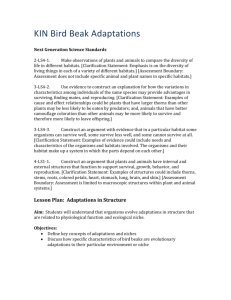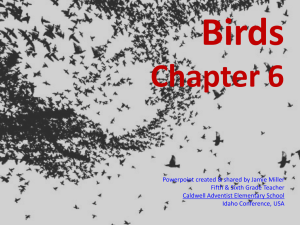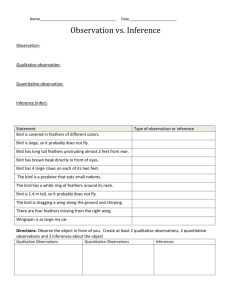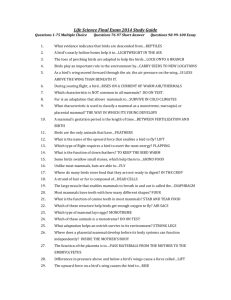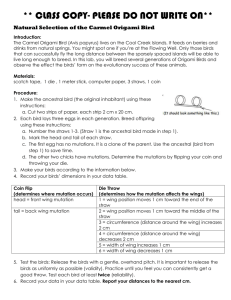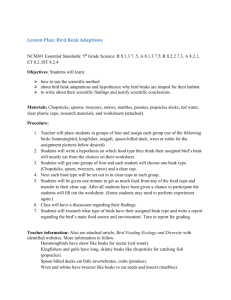Common Avian Emergencies
advertisement
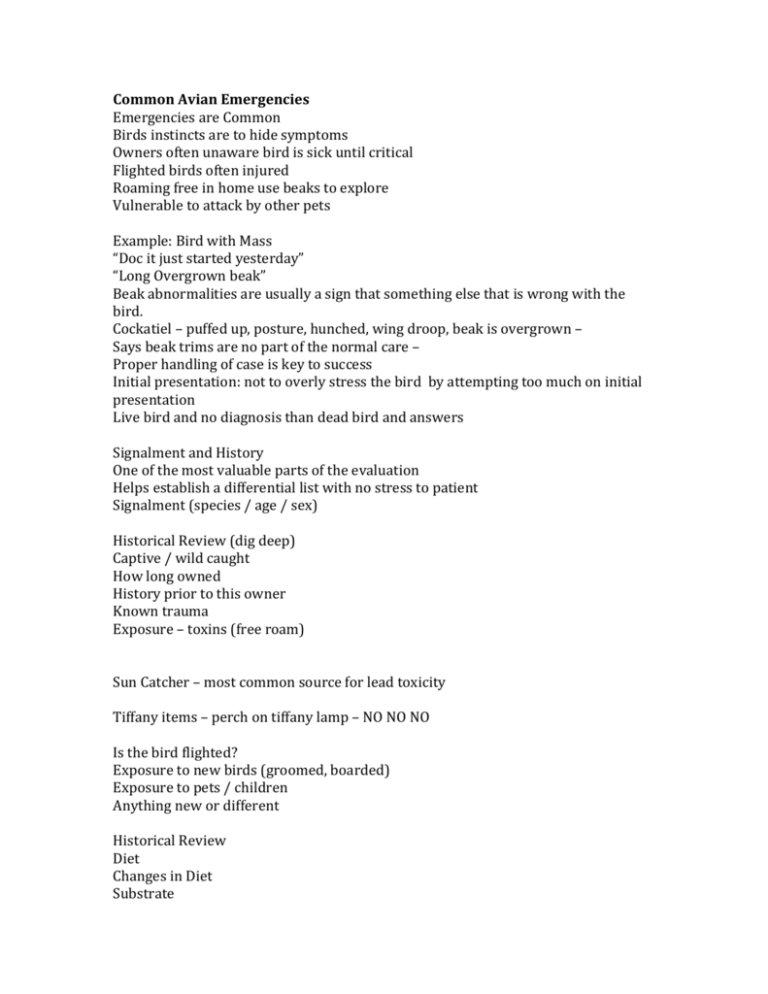
Common Avian Emergencies Emergencies are Common Birds instincts are to hide symptoms Owners often unaware bird is sick until critical Flighted birds often injured Roaming free in home use beaks to explore Vulnerable to attack by other pets Example: Bird with Mass “Doc it just started yesterday” “Long Overgrown beak” Beak abnormalities are usually a sign that something else that is wrong with the bird. Cockatiel – puffed up, posture, hunched, wing droop, beak is overgrown – Says beak trims are no part of the normal care – Proper handling of case is key to success Initial presentation: not to overly stress the bird by attempting too much on initial presentation Live bird and no diagnosis than dead bird and answers Signalment and History One of the most valuable parts of the evaluation Helps establish a differential list with no stress to patient Signalment (species / age / sex) Historical Review (dig deep) Captive / wild caught How long owned History prior to this owner Known trauma Exposure – toxins (free roam) Sun Catcher – most common source for lead toxicity Tiffany items – perch on tiffany lamp – NO NO NO Is the bird flighted? Exposure to new birds (groomed, boarded) Exposure to pets / children Anything new or different Historical Review Diet Changes in Diet Substrate Cage Mate History of egg laying Corn Cob Bedding, Walnut Shells – aspergilosis – too much of a risk Newspaper – don’t worry about aspergilosis Hands Off Exam Observe patient in cage / carrier Note response to environmental stimuli Respiratory Rate Posture Droppings / Cage condition (xmas) Hands Off Exam Sleeping in front of you Important to warn owner how fragile bid is prior to handling Critical Cases Quickly check vital areas - oral cavity - Heart / lungs - Coelom / cloaca Ready to treat for shock after PE Pre-oxygenation may be necessary Sine cases require treatment of a specific problem prior to PE Bleeding Dyspnea Shock Birds that struggle with handling may need sedation for exam, diagnostics, therapeutics Medazalam (ask Rhoda) As permitted by patient’s condition (prior to treatment) HCT/TS CBC Chemistry Chlamydia C/S Standing rads for heavy metal Once patient is stabilized other diagnostics Specific testing Aspergillosis PDD Lead/Zinc Radiographs Ultrasound Endoscopy Critically ill birds Treat cautiously to avoid stress / death Each treatment weighed for benefit: danger ratio Lead or zinc – pinkness to urate / chartreuss green / watery dropping – causes true diarrhea Most patients stabilized in a warm (85-90 F) humid, quiet environment Patient with head trauma should be placed in cool 75 degree incubator Initially WDQ – Warm Dark Quiet Food and water placed on Floor of incubator Oxygen Observe Maintenance fluid requirement 40-60 ml / kg/ day 5% of body weight 100g bird – 5 ml Shock Fluids 90 ml / kg / hr Fluid therapy Subcutaneous fluids initially less stressful Can then follow with IV or IO fluids after more stable Caution with large boluses of IV or IO fluids Hypervolemia Cardiac overload Can give – 1cc per 50 gm slow bolus Steroids Dexamethasone (1 mg / kg IM/IV) Shock (single dose) NSAIDS Instead (Meloxican, Metacam) Antimicrobials Antibiotics Antifungals Butorphanol (kappa receptors) very short acting Torbugesic (?) NSAIDS Meloxican0.2 – 0.6 mg / kg Tube feeding Initiated once patient is stabilized and hydrated Start w/ smarway via entotracheal tube or air sac cannulall volumes of diluted easily digestible formulas Benefit : risk ratio Guidelines for gavage feeding Should be warmed (100 – 1004 f) Approximately 2-3% of body weight can be given at one time 100g m bird 2-3 cc palpate crop before each feeding Cardiopulmonary Resusitation CPR Establish airway via entrotracheal tube or air sac cannula Administer positive pressure ventilation every 3-5 seconds Epinephrine may also be given IV , IC, OR IT IF NO HEART BEAT OR PULSE, GIVE RAPID STERIOD Avian Emergencies / Regurgitation / Vomiting History Presents for regurg / vomiting Unusual neck movements Owner not aware is regurg / vomiting presents for SBS Syndromes ADR – Aint Feelin’ right SBI – something bad inside Physical Exam: Dried mucus present on top of head Possible abdominial distention PE may be normal Behavioral Infectious - Bacterial - Fungal - Parasitic - Viral (PDD) Toxins - Lead/Zinc - Plants - Insecticides - Food Metabolic - Liver - Kidney Neoplasia Foreign Body ingestion Drugs Diagnostics: Based on good history Standing radiographs Crop wash – cytology / direct Fecal evaluation (AGY, occult blood) CBC / Chemistry Other Dx once more stable Survey radiographs Infectious agents Treatment: Supportive – address fluid loss Parenteral drugs initially (why? System is inflamed make sure drugs go where you want them to go) Specific therapy - chelation - antibiotics Treatment: GI protetants - activated charcoal - sucralfate Fasting to rest GI tract initially Slowly weaned back to normal food Neurological Disease History Need detailed HX (many etiologies) O may present for: - inability to perch - ataia - head tilt - paresis/ paralysys Rule outs: Trauma, - Brain / Spinal coard - Peripheral Nerves Toxins - heavy metal - houserplants / drugs / etc. - metabolic disease hypocalcemia hypoglycemia hepatic disease Rule outs Infectious Bacterial Chlamydia Viral (PDD, PBFD) Sarcocystis Fungal (crypto) Egg yolk stroke Dystocia Pituitary neoplasia Neurological Disease Initially: Standing radiographs CBC / Blood Chem Once more stable: Thorough neurological exam More specific testing: Survey radiographs Viral testing (borna) Heavy metal (lead/zinc) Microbiology Treatment Initial supportive care followed by specific treatment Chelating agents Ca2+EDTA Activated charcoal Dextrose, calcium Seizures – diazepam .5-1.0 mg/kg IM/IV/vent NSAIDS (PDD) RESPIRATORY DISTRESS History Bird breathing w/ difficulty Increased respiratory rate Tail bob Exercise intolerance History for tracheal obstruction differs Hear squeak / wheeze Change in the birds voice *** Change in posture - leaning forward - neck extended Examination - Brief and cautious - Auscultate heart / lungs - Assess tracheal noise / stridor - Coelom palpation - Differentiate upper from lower respiratory disease - Open mouth to separate glottis from choana - Listen for tracheal noise / stridor Diagnostics - Stabilize first - Radiographs - Endoscopy - Ultraound (coelom +) - CBC / chem - Microbiology Primary Disease - Bacterial, Fungal - Chlamydia Sarcocystis Respiratory toxins (PTFE) Allergic pneumonitis Seconary Disease - Cardiac Coelomic - Ascites - Organ enlargement - Reproductive - Neoplasia Tracheal Disease - seed hull / food aspiration - aspergillosis - bacterial - squamous netaplasia - toxin damage





